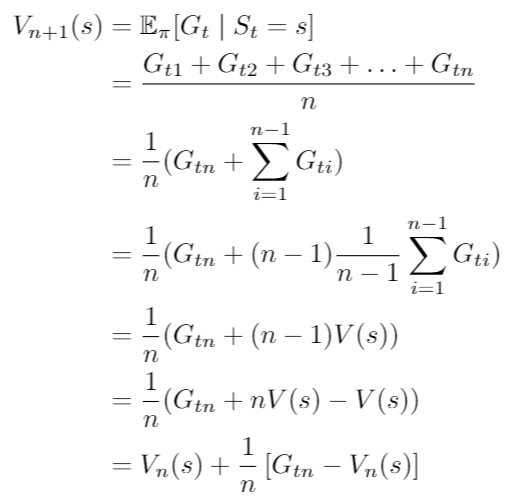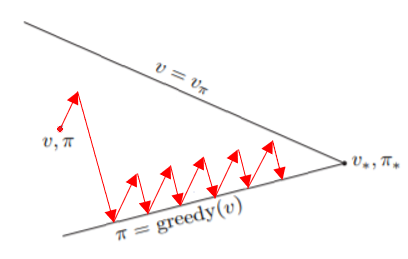Monte Carlo Method需要等到整個episode跑完才能更新,如果episode需要很多step才能結束的話會怎樣?如果你拿Monte Carlo去跑Taxi環境的話,會發現需要跑很久。這是因為我們State與Action太多,再加上隨機策略要到達Final State需要相當多step,進而造成更新很慢。
我們可以引進dynamic programming裡bootstrapping的概念,每個state只須依據下個state的值來更新,就不用等到episode跑完浪費時間了。
這種Monte Carlo裡的sample概念與dynamic programming裡的bootstrapping概念一起使用的算法就稱為時序差分學習 (Temporal difference learning),簡稱TD Learning。
我們先從Monte Carlo來看,Monte Carlo的更新方法很簡單,依照 來更新Value。
來更新Value。
期望值可以用平均來計算,所以可以寫成

這邊用表示目前考慮幾次
,
為考慮n個不同的
之平均。
這就是前天結尾說的用incremental取代平均值,可以把的部分可以換成任意值,稱為step-size或learning rate,通常以
表示。
這種方法的好處是越後面的資訊不會被前面的資訊稀釋。舉例來說,假如環境是會變動的,如果我們step-size用原本的
的話,環境變動後我們得到的
對期望值的影響會隨著
變大而越來越小。如果將step-size設為常數,變動後的
都會有固定比例來改變期望值
的值。
所以Monte Carlo公式可以寫成這樣:
這邊就不特別把
的
寫出來了,但實際上一樣是根據每個
的值來增加
還記得的期望值嗎?

我們可以將以上面期望值的形式取代,形成期望值的期望值,這種更新方法就稱為Temporal difference learning。

可以證明TD Learning一樣可以收斂,且理論上收斂的速度比Monte Carlo還要快
公式中稱為TD error,可以想成我們目前的估計值
與真實值
的差距。當差距越大,
的更新越多,當差距越小,
的更新就越少。
事實上,Monte Carlo Method就是一種多步更新的TD Learning,可以從Monte Carlo的error看到;
Monte Carlo的error其實就是TD error的總和,也就是將TD Learning延伸到整個episode在算error來更新,更多細節會在之後的n-step TD learning提到。
TD Learning一樣可以視為一種GPI的形式
其中,更新Value的部分就是用上面的更新,而Policy一樣以
-greedy的方式更新(因為要持續exploration),最後就能找到最佳解。
了解TD Learning的更新方式後,明天就可以直接來實作兩種TD Learning的演算法:Sarsa與Q Learning,與他們的變形。學會這兩個演算法後,就可以解決在有限state裡大部分的Reinforcement Learning問題了!
